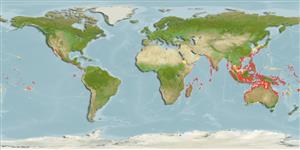>
Eupercaria/misc (Various families in series Eupercaria) >
Labridae (Wrasses) > Corinae
Etymology: Pseudocoris: Greek, pseudes = false + Greek, kore = pupil (Ref. 45335).
More on author: Bleeker.
Environment: milieu / climate zone / depth range / distribution range
Ecología
marino asociado a arrecife; no migratorio; rango de profundidad 2 - 54 m (Ref. 37816), usually 15 - 24 m (Ref. 90102). Tropical
Pacific Ocean: from the Line Islands to Indonesia, north to Taiwan and southern Japan, and south to the Great Barrier Reef.
Tamaño / Peso / Age
Maturity: Lm ? range ? - ? cm
Max length : 20.0 cm TL macho / no sexado; (Ref. 9710); common length : 15.0 cm SL macho / no sexado; (Ref. 37816)
Espinas dorsales (total): 9; Radios blandos dorsales (total): 12; Espinas anales 3; Radios blandos anales: 12. Color changes quickly from when moving from swimming near the bottom to open water to feed and the striped pattern of the female fades to an even grey that makes them difficult to see. Males have a variable banded pattern and this also changes with moods (Ref. 48636).
Found in outer reef crests in small aggregations (Ref. 8631). Females occur in small groups, and usually a male is nearby (Ref. 48636). Usually well above open bottoms with mixed sand, rubble, and coral (Ref. 9710). Found in areas periodically exposed to strong currents (Ref. 90102). Feeds on zooplankton (Ref. 9710).
Life cycle and mating behavior
Madurez | Reproducción | Puesta | Huevos | Fecundidad | Larva
Oviparous, distinct pairing during breeding (Ref. 205).
Kailola, P.J., 1987. The fishes of Papua New Guinea: a revised and annotated checklist. Vol. II Scorpaenidae to Callionymidae. Research Bulletin No. 41, Research Section, Dept. of Fisheries and Marine Resources, Papua New Guinea. (Ref. 6192)
IUCN Red List Status (Ref. 130435)
Threat to humans
Harmless
Human uses
Más información
ReferenciasAcuiculturaPerfil de acuiculturaRazasGenéticaElectrophoresesheritabilidadEnfermedadesProcesamientoNutrientsMass conversion
ColaboradoresImágenesStamps, Coins Misc.SonidosCiguateraVelocidadTipo de nataciónSuperficie branquialOtolitosCerebrosVisión
Herramientas
Special reports
Download XML
Fuentes de Internet
Estimates based on models
Preferred temperature (Ref.
123201): 24.6 - 29, mean 27.9 °C (based on 280 cells).
Phylogenetic diversity index (Ref.
82804): PD
50 = 0.5020 [Uniqueness, from 0.5 = low to 2.0 = high].
Bayesian length-weight: a=0.00977 (0.00470 - 0.02030), b=3.07 (2.89 - 3.25), in cm total length, based on LWR estimates for this (Sub)family-body shape (Ref.
93245).
Nivel trófico (Ref.
69278): 3.4 ±0.45 se; based on food items.
Resiliencia (Ref.
120179): Medio, población duplicada en un tiempo mínimo de 1.4-4.4 años (Preliminary K or Fecundity.).
Fishing Vulnerability (Ref.
59153): Low vulnerability (10 of 100).
Nutrients (Ref.
124155): Calcium = 71.5 [42.3, 123.7] mg/100g; Iron = 0.764 [0.444, 1.417] mg/100g; Protein = 18.2 [15.4, 20.5] %; Omega3 = 0.153 [0.095, 0.244] g/100g; Selenium = 26.7 [15.6, 50.0] μg/100g; VitaminA = 199 [62, 694] μg/100g; Zinc = 1.49 [1.02, 2.33] mg/100g (wet weight);
